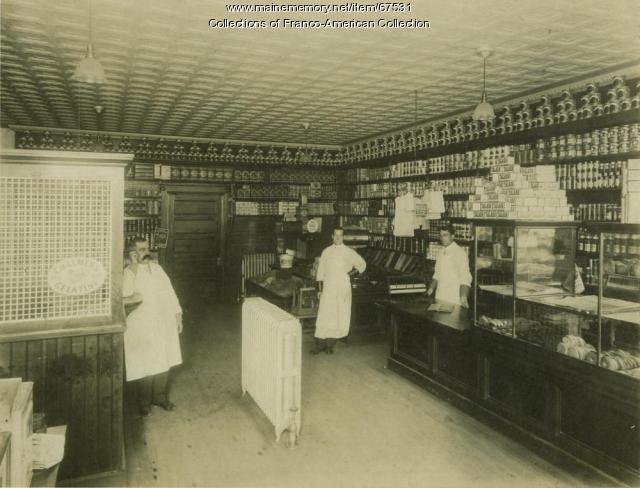Keywords: Franco-Americans
Item 67531
General Store, Auburn, ca. 1920
![]() What is the name of this Auburn grocery?
What is the name of this Auburn grocery?
Contributed by: Franco-American Collection, University of Southern Maine Libraries Date: circa 1920 Location: Auburn Media: Photographic print
Item 98763
Garde d’Honneur, Association St. Dominique, Lewiston, ca. 1920
Contributed by: Beatrice Gendron Guimond through Franco-American Collection, University of Southern Maine Libraries Date: circa 1920 Location: Lewiston Media: Photographic print
Exhibit
From French Canadians to Franco-Americans
French Canadians who emigrated to the Lewiston-Auburn area faced discrimination as children and adults -- such as living in "Little Canada" tenements and being ridiculed for speaking French -- but also adapted to their new lives and sustained many cultural traditions.
Exhibit
In the early 1600s, French explorers and colonizers in the New World quickly adopted a Native American mode of transportation to get around during the harsh winter months: the snowshoe. Most Northern societies had some form of snowshoe, but the Native Americans turned it into a highly functional item. French settlers named snowshoes "raquettes" because they resembled the tennis racket then in use.
Site Page
View collections, facts, and contact information for this Contributing Partner.
Site Page
Franco-American Heritage Center at St. Mary's
View collections, facts, and contact information for this Contributing Partner.
Story
Dr Michael Guignard: Passion for research & Franco-American root
by Biddeford Cultural & Heritage Center
A personal journey of life in a Franco-American community with unique insights on adoption
Story
Dr. Norman Beaupré: Preserving his Franco-American culture
by Biddeford Cultural & Heritage Center
Journey growing up as a Franco-American in Biddeford to his career as a professor and author.
Lesson Plan
Grade Level: 3-5
Content Area: Health Education & Physical Education, Social Studies
This lesson plan will introduce students to myriad communities in Maine, past and present, through the universal lens of sports and group activities. Students will explore and understand the history of many of Maine’s recreational pastimes, what makes Maine the ideal location for some outdoor sports, and how communities have come together through team activities throughout Maine’s history.
Lesson Plan
Maine's Acadian Community: "Evangeline," Le Grand Dérangement, and Cultural Survival
Grade Level: 9-12
Content Area: English Language Arts, Social Studies
This lesson plan will introduce students to the history of the forced expulsion of thousands of people from Acadia, the Romantic look back at the tragedy in Henry Wadsworth Longfellow's famous epic poem Evangeline and the heroine's adoption as an Acadian cultural figure, and Maine's Acadian community today, along with their relations with Acadian New Brunswick and Nova Scotia residents and others in the Acadian Diaspora. Students will read and discuss primary documents, compare and contrast Le Grand Dérangement to other forced expulsions in Maine history and discuss the significance of cultural survival amidst hardships brought on by treaties, wars, and legislation.















